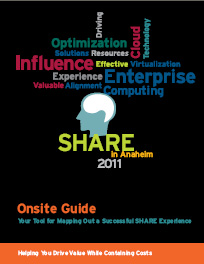 Microsoft’s Worldwide Partner Conference just wrapped up and it was truly an International conference. There were partners from every corner of the world. Microsoft has invested a lot in this conference and they are doing a great job of helping companies meet new partners through the on-line WPC Connections web site.
Microsoft’s Worldwide Partner Conference just wrapped up and it was truly an International conference. There were partners from every corner of the world. Microsoft has invested a lot in this conference and they are doing a great job of helping companies meet new partners through the on-line WPC Connections web site.
It is clear to me that Microsoft is converging a wide range of products onto the SQL Server platform for data management. The many business applications under the Microsoft Dynamics label including Dynamics NAV (the ERP system), Dynamics CRM (customer relationship management), and Dynamics AX (global ERP management) are all based on the latest version of SQL Server. The very popular SharePoint collaboration tool now fully supports and exposes SQL Server Enterprise edition. All of the Business Intelligence solutions have been based on SQL Server for some time. And this pattern repeats through other products.
Why is this important? In SQL Server 2008 Microsoft introduced a new database security architecture with Extensible Key Management (EKM). EKM enables database encryption and the use of Hardware Security Modules (HSM) to store and manage encryption keys. Encryption and good key management are crucial to regulatory compliance, and the EKM architecture makes this all possible. The EKM architecture extends forward to the new version of SQL Server code named Denali.
You will be hearing more from Townsend Security about Microsoft SQL Server encryption key management next month.
The Cloud is the other big topic at this conference. Microsoft is moving almost everything to the Cloud at full speed. Microsoft Dynamics, SharePoint, SQL Server, and many other products are getting Cloud-based versions. Microsoft may be a bit late to the game on the Cloud, but they are “all in” now. And they’ve made a lot of room for partners to play in this arena, too. There are a really large number of new and existing Cloud providers at WPC.
Of course, the biggest concern on the part of end customers is the security of the Cloud. After many discussions with Microsoft partners, I know that they have heard this concern. But there is still quite a bit of confusion and ignorance about how to mitigate risk in Cloud environments. I can see we have our work cut out for us in helping to educate the Microsoft partner community about how they can use our solutions to encrypt and protect customer data. It won’t be as hard, painful, and expensive as they think.
Be sure to follow us on Facebook, Twitter, and LinkedIn to hear more about what we are doing with Key Management for SQL Server 2008 and stay up to date on the latest trends in data protection.
Patrick




 As I talk to Enterprise customers I’m finding a lot of confusion about when to use encryption or tokenization, and how to think about these two data protection technologies. Once you understand how each of these technologies work, you understand that there are no easy answers to which is best for you, or when one is better than another. I want to talk about some general guidelines I’ve developed to help with this conundrum.
As I talk to Enterprise customers I’m finding a lot of confusion about when to use encryption or tokenization, and how to think about these two data protection technologies. Once you understand how each of these technologies work, you understand that there are no easy answers to which is best for you, or when one is better than another. I want to talk about some general guidelines I’ve developed to help with this conundrum.
 Smart phone payment systems have exploded over the last few months offering the specter of turning every street vendor into a walking, talking, credit-card accepting, free-spirited merchant. In some cases smart phone payment vendors are giving away free card readers just by signing up. Some people saw this as the welcome exuberance of democratic capitalism with innovation driving new opportunities. Others saw this as the apocalypse for credit card security. Is there some middle ground here?
Smart phone payment systems have exploded over the last few months offering the specter of turning every street vendor into a walking, talking, credit-card accepting, free-spirited merchant. In some cases smart phone payment vendors are giving away free card readers just by signing up. Some people saw this as the welcome exuberance of democratic capitalism with innovation driving new opportunities. Others saw this as the apocalypse for credit card security. Is there some middle ground here? When I had this “Aha” moment years ago, I realized that our company had to radically change how we approached the development of our encryption and key management products. I knew that we had to step up to much higher standards, and change how we looked at our own products. But where does one go to figure out how to do encryption right? Fortunately, our company had several good enterprise customers who helped point the way. Enterprise security architects directed us to the National Institute of Standards and Technology (NIST) web site and the FIPS-140 certification process. The NIST and FIPS-140 certification outline the proper standards and best practices for encryption, decryption, key management, and logging. So began the complete transformation in how we bring Townsend Security encryption products to market.
When I had this “Aha” moment years ago, I realized that our company had to radically change how we approached the development of our encryption and key management products. I knew that we had to step up to much higher standards, and change how we looked at our own products. But where does one go to figure out how to do encryption right? Fortunately, our company had several good enterprise customers who helped point the way. Enterprise security architects directed us to the National Institute of Standards and Technology (NIST) web site and the FIPS-140 certification process. The NIST and FIPS-140 certification outline the proper standards and best practices for encryption, decryption, key management, and logging. So began the complete transformation in how we bring Townsend Security encryption products to market. Well, you already know how this came out. In the end I could come to no other conclusion. We would either do the right thing, or get out of the security market altogether. We’re still in, so you know that we made that commitment and investment in NIST certification of our correctly implemented encryption solutions. We did learn a lot about encryption development processes and best practices. And I must say our products are so much better for it.
Well, you already know how this came out. In the end I could come to no other conclusion. We would either do the right thing, or get out of the security market altogether. We’re still in, so you know that we made that commitment and investment in NIST certification of our correctly implemented encryption solutions. We did learn a lot about encryption development processes and best practices. And I must say our products are so much better for it.
 As you probably know “Phishing” is the security term used for email that looks perfectly valid, but which contains links or attachments that can infect your PC. Really good phishing email looks like it came from someone you know, or from a business that you work with and trust. A well-crafted Phishing scheme lowers your defenses. You say to yourself, “I’m glad John got back to me on that financial plan.” Or, “I wonder why Wal-Mart is having trouble with my invoice.” And a click or two later and you’ve fallen victim to a phishing attack.
As you probably know “Phishing” is the security term used for email that looks perfectly valid, but which contains links or attachments that can infect your PC. Really good phishing email looks like it came from someone you know, or from a business that you work with and trust. A well-crafted Phishing scheme lowers your defenses. You say to yourself, “I’m glad John got back to me on that financial plan.” Or, “I wonder why Wal-Mart is having trouble with my invoice.” And a click or two later and you’ve fallen victim to a phishing attack. As it turns out, the weakness, in these devices, was not in the actual AES encryption, but in the key management processes. All the affected vendors quickly released replacements or patches to fix the problem, which is the right thing to do. But it was fascinating to watch some of the responses to this problem. Many commentators complained that the FIPS-140 testing was faulty, or that FIPS-140 testing was irrelevant. The implication is that FIPS-140 does not really give you any assurance of security, and therefore, also by implication, that it is not important.
As it turns out, the weakness, in these devices, was not in the actual AES encryption, but in the key management processes. All the affected vendors quickly released replacements or patches to fix the problem, which is the right thing to do. But it was fascinating to watch some of the responses to this problem. Many commentators complained that the FIPS-140 testing was faulty, or that FIPS-140 testing was irrelevant. The implication is that FIPS-140 does not really give you any assurance of security, and therefore, also by implication, that it is not important. First, FIPS-140 certification is not a guarantee of security. It is an assurance that encryption and related security algorithms have been implemented in compliance with published standards, that an application uses good practices in exposing it’s operational interfaces, that start up tests validate that the application has not been modified or corrupted, that cryptographic material is not exposed in application logs or leaked to memory, and that an independent expert has reviewed the source code. Going through a FIPS-140 certification is a grueling process for an encryption vendor and almost always results in finding some issues that need to be addressed to make the product more secure. Companies that engage in FIPS-140 certifications produce better products, and become better security designers in the process.
First, FIPS-140 certification is not a guarantee of security. It is an assurance that encryption and related security algorithms have been implemented in compliance with published standards, that an application uses good practices in exposing it’s operational interfaces, that start up tests validate that the application has not been modified or corrupted, that cryptographic material is not exposed in application logs or leaked to memory, and that an independent expert has reviewed the source code. Going through a FIPS-140 certification is a grueling process for an encryption vendor and almost always results in finding some issues that need to be addressed to make the product more secure. Companies that engage in FIPS-140 certifications produce better products, and become better security designers in the process.
 I found the data breach of Epsilon just shocking for several reasons:
I found the data breach of Epsilon just shocking for several reasons: We've been tracking the growing need for encryption and key management to secure the mass of data that is (or soon will be) residing in the Cloud. To address this issue, a security group was recently formed that is completely focused on Cloud security. If you’ve not visited the Cloud Security Alliance web site, it is well worth a visit at www.cloudsecurityalliance.org.
We've been tracking the growing need for encryption and key management to secure the mass of data that is (or soon will be) residing in the Cloud. To address this issue, a security group was recently formed that is completely focused on Cloud security. If you’ve not visited the Cloud Security Alliance web site, it is well worth a visit at www.cloudsecurityalliance.org.
 It was a great time of year to be in Anaheim, California last week for the IBM System z Mainframe SHARE user conference. The rains had just passed through and the weather was balmy. The Anaheim convention center is right next door to Disneyland, a place that was paradise to me growing up in Southern California. The juxtaposition was not lost on anyone – Mainframes being the really serious computing platform, and Disneyland being the silliest and most fun place on planet Earth. But there was fun at the SHARE conference, too.
It was a great time of year to be in Anaheim, California last week for the IBM System z Mainframe SHARE user conference. The rains had just passed through and the weather was balmy. The Anaheim convention center is right next door to Disneyland, a place that was paradise to me growing up in Southern California. The juxtaposition was not lost on anyone – Mainframes being the really serious computing platform, and Disneyland being the silliest and most fun place on planet Earth. But there was fun at the SHARE conference, too. Now that the new version of the PCI Data Security Standard (PCI DSS version 2.0) is in effect, many IBM i (AS/400, iSeries) customers are getting dinged on their PCI compliance in the area of encryption key management. The renewed focus on "Dual Control" and "Separation of Duties" by QSA auditors is forcing many IBM i customers to move from homegrown key management to a better method of securing keys. This is even happening for IBM i customers who use IBM’s Master Key and key database facility. Why is this? There is just no way to properly implement effective security controls for the QSECOFR user, or for any user with All Object (*ALLOBJ) authority. Thus no "Dual Control" and no "Separation of Duties." And QSA auditors have figured this out.
Now that the new version of the PCI Data Security Standard (PCI DSS version 2.0) is in effect, many IBM i (AS/400, iSeries) customers are getting dinged on their PCI compliance in the area of encryption key management. The renewed focus on "Dual Control" and "Separation of Duties" by QSA auditors is forcing many IBM i customers to move from homegrown key management to a better method of securing keys. This is even happening for IBM i customers who use IBM’s Master Key and key database facility. Why is this? There is just no way to properly implement effective security controls for the QSECOFR user, or for any user with All Object (*ALLOBJ) authority. Thus no "Dual Control" and no "Separation of Duties." And QSA auditors have figured this out.